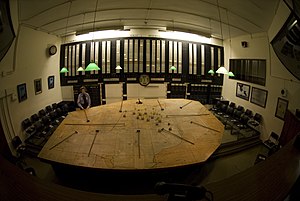Battle of Britain Bunker
| Battle of Britain Bunker | |
|---|---|
| Uxbridge, Middlesex, England | |

The No.11 Group Operations Room
|
|
| Coordinates | 51°32′28.5″N 000°27′55″W / 51.541250°N 0.46528°WCoordinates: 51°32′28.5″N 000°27′55″W / 51.541250°N 0.46528°W |
| Type | Underground operations room |
| Site information | |
| Condition | Heritage attraction with museum |
| Site history | |
| Built | February - August 1939 |
| Built by | Sir Robert McAlpine |
| Battles/wars | Battle of Britain |
| Garrison information | |
| Occupants | Royal Air Force |
The Battle of Britain Bunker is an underground operations room at RAF Uxbridge, formerly used by No. 11 Group Fighter Command during the Second World War. Fighter aircraft operations were controlled from there throughout the War but most notably during the Battle of Britain and on D-Day. Today it is run by the Royal Air Force as a Force Development asset, but can also be visited by the general public as a heritage attraction with attached museum.
The Bunker is located at RAF Uxbridge, not far from Uxbridge town centre and Uxbridge Underground station.
As the location of No. 11 Group RAF's Operations Room, The Battle of Britain Bunker was one of the key parts of the world's first Integrated air defence system. Often known as the "Dowding system" (after Air Chief Marshal Sir Hugh Dowding, Commander-in-Chief Fighter Command at the time of installation), the system linked Fighter Command with Anti-Aircraft Command, Barrage Balloon Command, the Observer Corps, Chain Home Radio Direction Finding (radar), and the intelligence services. Under the system, these organisations worked together for the first time in order to achieve one goal: the successful defence of the UK's airspace.
No.11 Group was an important part of the system for several reasons: Firstly, as one of four group headquarters, No.11 Group's Operations Controller was responsible for making key decisions that would affect the outcomes of aerial battles - how many fighter aircraft to scramble, which type of aircraft, which squadrons to use, when to scramble them, where to scramble them from, where to scramble them to, etc. Secondly and also due to its role as a group headquarters, No.11 Group was responsible for organising and coordinating the activities of seven sector stations at which its fighter squadrons were based - RAFs Kenley, North Weald, Debden, Biggin Hill, Tangmere, Hornchurch and Northolt. And thirdly, the Bunker and its Operations Room were the prototypes by which the other three group headquarters (No.10 Group, RAF Box; No.12 Group, RAF Watnall; No.13 Group, RAF Newcastle) were planned and constructed.
...
Wikipedia
